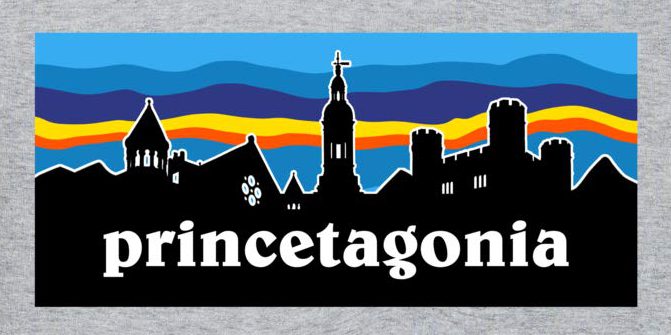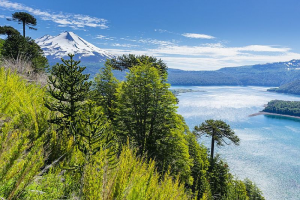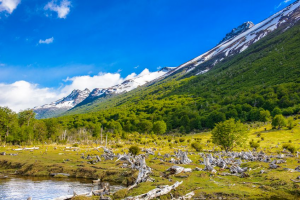By Claire Schmeller
Patagonia, a region in Southern Chile and Argentina, attracts thousands of visitors each year on account of its unique landscapes and experiences. National Parks and other tourist attractions sustain large numbers of foreign visitors each year. The challenge remains for the national park systems to create and enact policies that value infrastructure necessary for the economy while protecting the land in accordance with their goals in conservation.
National Parks have greatly contributed to the development of both Argentina and Chile. The first park in Argentina was established by Dr. Francisco Moreno in 1903. He donated about 7,500 hectares of land to the Argentine government, where the first national park was created in 1922 and called Del Sur. This park is now called Nahuel Huapi and is one of the largest national parks in the region. These first steps created a precedent which favored conservation. On the Chilean side, conversations about protecting land began around 1880. The United States inspired conservation in both countries with the creation of Yellowstone National Park. Chile created its first protected area in 1907, called Malleco Forest Reserve. This came after a development of laws slowly restricting use of the lands and natural resources of Chile.
Chile itself has 41 National Parks, 46 National Reserves, and 18 Natural Monuments. The parks alone span across more than 9 million hectares of land, which can be compared to about 14 million hectares of agricultural land. Argentina has 40 National Parks; both systems have comparable strength. Regionally, Patagonia holds some of the largest conservation areas in each nation. There are 11 Parks and 3 Monuments on the Argentine side, and there are 9 Parks along with many other reserves in Chile. The services that parks provide range across the region but include a plethora of activities like hiking, swimming, climbing, and viewing spectacular sights. These are strengthened by the diversity of landscapes within Patagonia and differ between the two countries in management of nationally owned lands. Defining a national interest in protecting land is important in order to ensure that conservation occurs sustainably.
Parks Mentioned

Villarrica National Park is located in the region of Araucanía in Chíle. It is known for its active volcano also called Villarrica, which is the most active volcano in South America. The park has hours of trails, as well as many protected species including the Araucaria araucana which is perhaps the most prominent in the deciduous forests.
On the Argentina side, 8 parks can be found in Patagonia: https://www.argentina.gob.ar/parquesnacionales/regionpatagonia
Also in Argentina, there are also 8 parks (two inter-jurisdictional) in Southern Patagonia: https://www.argentina.gob.ar/parquesnacionales/patagonia-austral
On the Chilean Side, there are parks and many other natural reservations of different distinctions in Northern Patagonia: https://www.gochile.cl/en/destinations-northern-patagonia-carretera-austral.htm
and in Southern Patagonia: https://www.gochile.cl/en/destinations-southern-patagonia-torres-del-paine-tierra-del-fuego.htm
Parks systems, in Patagonia and otherwise, are forced to work with multiple levels of leadership; different regions of the system are subject to policy decision on the basis of priorities. Chile is itself divided into two main agencies: the Agricultural and Livestock Service and the National Forest Corporation. These two entities have different values and motivations, yet both manage to act with significant emphasis on conservation. Argentina establishes jurisdiction through the Administratión des Parques Nacionales (APN) in conjunction with its provinces. Jack Hopkins notes that consensus in 1990 was reached that, “management of national parks would be ‘federalized’ by means of the presence of the provinces on the directorio of the APN. Management plans would be regionalized in order to incorporate the socioeconomic realities of the area in which parks are located.” Provincial administrations act on a more individual basis. Taking into account the needs of the area can sometimes bias policy towards economic development, in order to benefit industry instead of biodiversity.
One ecologist noted the system as well-consolidated but one with certain biases within the park management, including training of park rangers versus professional scientists. This often results in switching between military-style operations and scientific leadership, which changes the goal of decision-making. One distinction of preservation made by Argentina is the natural monument, which “is used for the protection of very particular environments or species in danger of extinction.” Management plans for natural monuments often lack enforcement, making the monument classification less effective than hoped in protecting endangered species. Both systems work in order to avoid upsetting the balance between economic development and biodiversity. A future that provides for all occupants of Patagonian lands requires careful management.

To my reader: Explore the website, tabs, and links, and come back here to wrap up.
Patagonia as a region has historically been, and even currently is, a mysterious place to those who are unacquainted to it. As Chile and Argentina have developed and strengthened, the mystery has slowly been uncovered. Infrastructure like the national park systems have organized the land and its occupants, and now are relied upon by all aspects of the place. Biodiversity and the natural environment are often solely protected by regulations and laws, and globalization has brought more and more people to this southernmost part of the world. As populations grow, land is developed, and economies are built, the park systems become most important to protect the native flora and fauna and ensure that their beauty is not lost for future generations.
Forest fires threaten people’s livelihood and must be mitigated to maintain peace and stability in the area, yet parks must also protect their natural treasures – those which are often sacrificed in the effort to suppress flames. The Patagonian landscape can no longer be wild, but people cannot take total claim to the resources. Parks serve as a go-between for these often-conflicted interests, simultaneously building infrastructure that can hold the development of the region and the world and limiting the contact of people with the natural side of the area. Management requires balance with every party’s interest in mind, something that individual problems like rampant forest fires or invasive Northern species can distract from. The ultimate challenge for parks, in setting a precedent for future administrations and an example for the world, is to build policies that acknowledge goals for conservation without stifling human growth and appreciation. Patagonia is one case study throughout the world, but it seeks to show the nuance that national park management requires.
Further Readings:
Blackhall, Melisa, Estela Raffaela, and Thomas T. Veblen. “Cattle Affect Early Post-Fire Regeneration in a Nothofagus dombeyi–Austrocedrus chilensis Mixed Forest in Northern Patagonia, Argentina.” Biological Conservation 141 (2008): 2251-61. Accessed April 15, 2020. https://doi.org/10.1016/j.biocon.2008.06.016.
González, Mauro E., Thomas T. Veblen, and Jason S. Sibold. “Fire History of Araucaria–Nothofagus Forests in Villarrica National Park, Chile.” Journal of Biogeography 32 (2005): 1187-202. Accessed April 28, 2020. https://doi.org/10.1111/j.1365-2699.2005.01262.x.
Hardenberg, Wilko Graf von, and Emily Wakild. The Nature State: Rethinking the History of Conservation. Abingdon, Oxon: Routledge, an imprint of the Taylor & Francis Group, 2017.
Hopkins, Jack W. Policymaking for Conservation in Latin America: National Parks, Reserves, and the Environment. Westport, Conn.: Praeger, 1995.
Kershaw, A. P. “Climatic Change and Aboriginal Burning in North-East Australia during the Last Two Glacial/Interglacial Cycles.” Nature 322, no. 3 (July 1986): 47-49. Accessed April 27, 2020. https://doi.org/10.1038/322047a0.
Martínez Pastur, Guillermo, Vanessa M. Lencinas, Julio Escobar, Paula Quiroga, Laura Malmierca, and Marta Lizzaralde. “Understorey Succession in Nothofagus Forests in Tierra del Fuego (Argentina) Affected by Castor canadensis.” Applied Vegetation Science 9, no. 1 (2006): 143-54. Accessed April 28, 2020. https://doi.org/10.1658/1402-2001(2006)9[143:USINFI]2.0.CO;2.
Mermoz, Monica, Thomas Kitzberger, and Thomas T. Veblen. “Landscape Influences on Occurrence and Spread of Wildfires in Patagonian Forests and Shrublands.” Ecology 86, no. 10 (2005): 2705-15. Accessed April 27, 2020. https://doi.org/10.1890/04-1850.
“National Park Administration.” Argentina Unida. Accessed April 15, 2020. https://www.argentina.gob.ar/parquesnacionales.
Veblen, Thomas T., Thomas Kitzberger, Estela Raffaela, Diane C. Lorenz, and Gloria Montenegro. Fire and Climatic Change in Temperate Ecosystems of the Western Americas. New York: Springer, 2002.
Veblen, Thomas T., Thomas Kitzberger, Ricardo Villalba, and Joseph Donnegan. “Fire History in Northern Patagonia: The Roles of Humans and Climatic Variation.” Ecological Monologues 69, no. 1 (February 1999): 47-67. Accessed April 27, 2020. https://doi.org/10.1890/0012-9615(1999)069[0047:FHINPT]2.0.CO;2.
Vergara, Pablo M., Luis O. Meneses, Marcelo Saavedra, Felipe E. Diaz, Katherine Norambuena, Andrés Fierro, Amanda D. Rodewald, and Gerardo E. Soto. “Magellanic Woodpeckers in Three National Parks of Central-Southern Chile: Habitat Effects and Population Variation over the Last Two Decades.” Avian Conservation and Ecology 12, no. 2 (2017). Accessed April 27, 2020. https://doi.org/10.5751/ACE-01106-120215.




